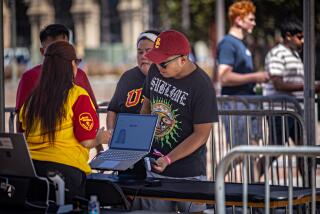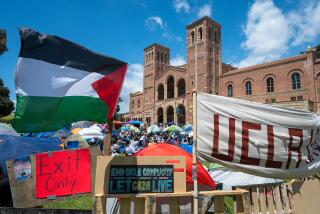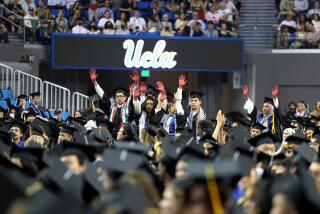UCLA Strike Grew From Deep Historical Roots
The UCLA student hunger strike was an example of what a powerful force political and cultural nationalism has become in the Southland.
Nationalism was the real issue in the 14-day fast. It ended Monday when the UCLA administration agreed to expand the Chicano studies program and name it after Cesar Chavez, the farm leader who inspired a generation of youngsters to search for strength and meaning in their Mexican roots.
They aren’t the kind of nationalists who want the mother country--in this case, Mexico--to send in troops to reconquer California. Rather, the Mexican flags they carried reflected a feeling of ethnic pride and power that has been submerged ever since the United States conquered California in 1848. The Treaty of Guadalupe Higaldo, signed that year, sealed the fate of Mexican culture in the conquered lands when it said remaining Mexicans “shall not preserve the character of citizens of the Mexican Republic.”
Although I knew the history, it was hard for me to be totally sympathetic when I visited the strike site last Thursday.
*
One thing I didn’t like was the college students’ effort to manipulate the media. Reporters had to sign up to interview the strikers, who were either resting in a large surplus army tent or sitting in the sunshine outside. “We’ve got room for four print, two cameras and two radio (reporters),” said a young woman in charge. A young man yelled at anyone who tried to talk to the strikers without permission.
I also was put off by the air of reverence. Some of the participants spoke in hushed tones, as if their enterprise extended beyond earthly bounds. Get off it, I thought. This is a political protest, not a religious service.
But as I walked away, I ran into someone who helped me put the strike into perspective. He was Art Goldberg, an attorney who was a leader of the biggest student strike ever against UC, the 1964 Berkeley Free Speech Movement.
What a coincidence, running into the famous old demonstrator at a demonstration. I had just heard students shouting chants whose genesis goes back to Goldberg’s day: “What do we want? Chicano studies. When do we want it? Now.” Or, “The people united will never be defeated.” Then it was “freedom” and later “end the war.” Today, “Chicano studies.”
Goldberg loved the scene. “Young people putting their lives on the line,” he said. Nineteen years after the FSM, he is still a curly haired, smiling man who looks friendly during the angriest encounters.
Goldberg was on his way to visit his children. Because protest remains a Goldberg family tradition, they had spent the night at the quad to show their support for the strikers.
“My white liberal friends can’t understand the fast,” he said. What baffled them was why young people would risk their health over what appeared to be a bureaucratic and academic dispute about establishing a department of Chicano studies when the subject has been part of the campus curriculum for 20 years.
We recalled Berkeley. We talked about history. We agreed that the strike wasn’t entirely about Chicano studies. The strikers were calling for recognition and respect for their roots.
By another coincidence, the ground we stood on, the UCLA campus, was part of their history. A.L. Kroeber, in his “Handbook of the Indians of California,” said the Shoshones who roamed the hills of Westwood 1,500 years ago were related to a “mass of allied tribes” that extended from Idaho and Montana to Panama. The Indians living in what was to become Los Angeles and Mexico City were related, Kroeber wrote. Those Mexican Indians, no doubt, were ancestors of some of the strikers, a point brought home by dancers at a noontime rally, dressed in the Indian garb of ancient Mexico.
When the Spaniards conquered the California Shoshones, they gave much of their land to favored Army vets. The Westwood hills and surrounding lands were included in three large ranchos--San Vicente y Santa Monica; San Jose de Buenos Ayres and Rodeo de las Aguas. After Mexico broke free from Spain, the ranchos were ruled by the new nation. Then came the Americans.
*
Each step of this history had more than its share of racism and violence, beginning with the Spanish conquest of the Indians down to the American takeover.
This past explains the intensity with which many Americans of Mexican descent are now demanding recognition and respect for their culture.
It also helps us understand the political conflict that is the inevitable result of Chicanos and Chicanas trying to reclaim their heritage on Southland city councils, school boards--and on the UCLA campus.
More to Read
Sign up for Essential California
The most important California stories and recommendations in your inbox every morning.
You may occasionally receive promotional content from the Los Angeles Times.









